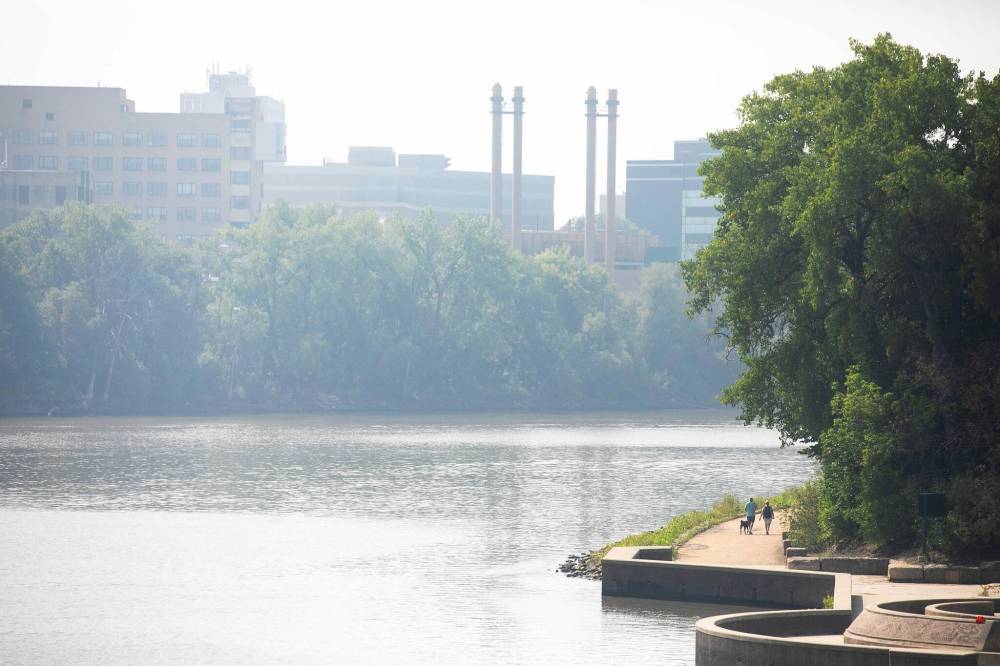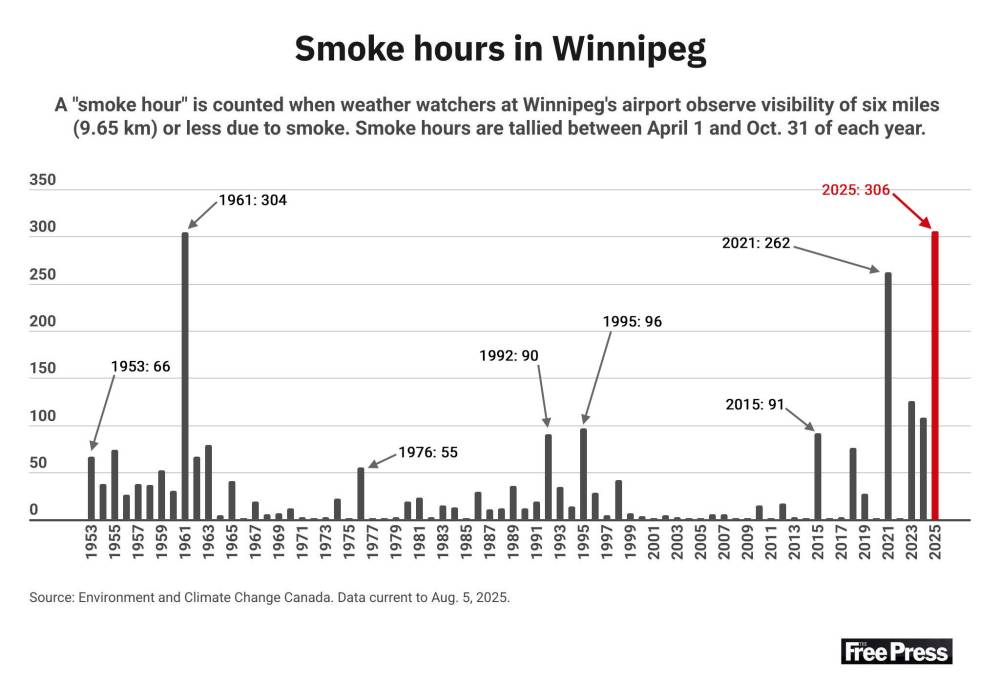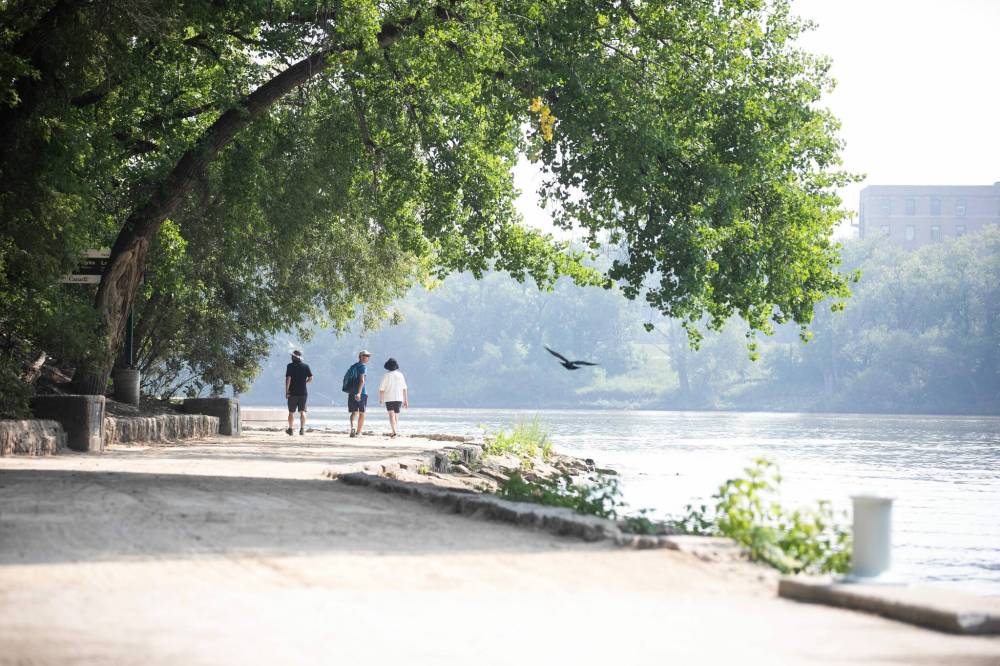Choking smoke in city ranks worst in Canada; health expert sounds alarm
Advertisement
Read this article for free:
or
Already have an account? Log in here »
To continue reading, please subscribe:
Monthly Digital Subscription
$0 for the first 4 weeks*
- Enjoy unlimited reading on winnipegfreepress.com
- Read the E-Edition, our digital replica newspaper
- Access News Break, our award-winning app
- Play interactive puzzles
*No charge for 4 weeks then price increases to the regular rate of $19.00 plus GST every four weeks. Offer available to new and qualified returning subscribers only. Cancel any time.
Monthly Digital Subscription
$4.75/week*
- Enjoy unlimited reading on winnipegfreepress.com
- Read the E-Edition, our digital replica newspaper
- Access News Break, our award-winning app
- Play interactive puzzles
*Billed as $19 plus GST every four weeks. Cancel any time.
To continue reading, please subscribe:
Add Free Press access to your Brandon Sun subscription for only an additional
$1 for the first 4 weeks*
*Your next subscription payment will increase by $1.00 and you will be charged $16.99 plus GST for four weeks. After four weeks, your payment will increase to $23.99 plus GST every four weeks.
Read unlimited articles for free today:
or
Already have an account? Log in here »
Much of Manitoba had the worst air quality in Canada Thursday, as researchers warn the long-term effects of the smog are not yet fully realized.
“We know that there’s increases in things like heart attacks and out-of-hospital cardiac arrest when it’s smoky outside. We are learning about the neurological symptoms and we are learning more about the metabolic effects,” said Sarah Henderson, the scientific director of Environmental Health Services at the BC Centre for Disease Control during a virtual Thursday news conference to provide an update on Canada’s wildfire situation.
“The key message here is that smoke affects the entire body.”

MIKAELA MACKENZIE / FREE PRESS
Smoke hangs over the Red River as people walk the River Trail at The Forks on Thursday.
AQMap, a site which compiles data on air quality from Environment and Climate Change Canada, showed parts of Winnipeg registered 269 Fine Particulate Matter (PM 2.5) Thursday afternoon. Areas in Saskatchewan registered second at 239 PM2.5.
Anything above 100 PM2.5 is considered very unhealthy.
Winnipeg set a record for its smokiest year to date. The city had recorded 306 smoke hours as of Tuesday, compared with 304 in 1961.
People with medical conditions such as asthma, COPD, chronic heart diseases and chronic kidney disease are all at a heightened risk for complications, but birth outcomes could also be affected.
“We know that there are birth outcomes associated with smoke exposures, so there is a higher risk of pre term birth for infants who were exposed to smoke well in utero. We know that there’s a higher risk of potential stillbirth,” Henderson said.
With drought-like conditions fuelling wildfires across Manitoba and smoke in the long-term forecast, Henderson said the only option is for people to protect themselves against exposure.
“The No. 1 piece of information that you will hear is go inside and close the windows and doors. That may help to protect people somewhat, but it is not enough,” she said.
Using indoor air purifiers and wearing masks are good ways to reduce smoke exposure, Henderson said.

Andrew Halayko, a professor of physiology and pathophysiology at the University of Manitoba’s Max Rady College of Medicine and Canada Research chair in lung pathobiology and treatment, said areas in Manitoba that were historically polluted could be greatly affected.
Halayko pointed to communities such as Flin Flon, which has a long history of mining and resource extraction and has polluted the nearby ground with heavy metals such as lead, mercury and selenium.
A fire in the region in late May forced the evacuation of the city, located about 760 kilometres northwest of Winnipeg.
“What happens to those metals when they’re released from the soil? Do they somehow chemically interact with particles that we’re inhaling? So now there’s an element to that particular smoke that’s more toxic,” he said. “These are questions we don’t know.”
Halayko is in the process of acquiring grants to further research how wildfire smoke interacts with other toxins, such as vehicle exhaust, and how it affects human health.
The professor said he’s also worried about how wildfire smoke will affect people psychologically; the directive to stay indoors is reminiscent of the COVID-19 pandemic and is changing social behaviours.
It also adds a layer of stress to those who live near wildfires but not close enough to be evacuated.
“I think you would just increase the all these stressors on your day-to-day life. People think, ‘That fire, although not in my backyard, is it actually going to take out the electricity to my town?’

MIKAELA MACKENZIE / FREE PRESS
Winnipeg had recorded 306 smoke hours as of Tuesday, compared with 304 in 1961.
“And what about people who are displaced? Maybe you’ve never been to Winnipeg. Never been in a large city. You’re now being asked to sleep in large rooms like the convention centre on cots (alongside) people that you don’t necessarily know. It’s incredibly devastating to those people. It’s got to be traumatic.”
Halayko speculated that there could be some urban migration in Manitoba due to repeated wildfires in the North, but Henderson stopped short of telling residents to make moving plans.
“We know we cannot predict where and when smoke will be, and so it’s really about learning to live with smoke when it occurs and developing that population scale resiliency, and thinking through all of the ways that we can reduce our exposure,” she said.
nicole.buffie@freepress.mb.ca

Nicole Buffie
Multimedia producer
Nicole Buffie is a reporter for the Free Press city desk. Born and bred in Winnipeg, Nicole graduated from Red River College’s Creative Communications program in 2020 and worked as a reporter throughout Manitoba before joining the Free Press newsroom as a multimedia producer in 2023. Read more about Nicole.
Every piece of reporting Nicole produces is reviewed by an editing team before it is posted online or published in print — part of the Free Press‘s tradition, since 1872, of producing reliable independent journalism. Read more about Free Press’s history and mandate, and learn how our newsroom operates.
Our newsroom depends on a growing audience of readers to power our journalism. If you are not a paid reader, please consider becoming a subscriber.
Our newsroom depends on its audience of readers to power our journalism. Thank you for your support.
History
Updated on Friday, August 8, 2025 11:29 AM CDT: Corrects typo



